
| Logout |
The State of the Program, Part 3: The Defense
by Will Stewart, TechSideline.com, 12/18/03
(Note: all pictures are clickable for larger images)
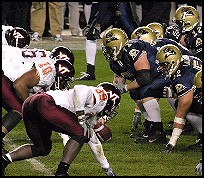 Welcome to
part 3 of our "State of the Program" series, where the topic is the defense.
Welcome to
part 3 of our "State of the Program" series, where the topic is the defense.
We all have in our minds a vision of the perfect Virginia Tech defense. They stuff the run, they fly to the ball, they pressure the quarterback with a relentless pass rush, and they don't give up a lot of points, particularly when the Hokies have a lead. That vision hasn't been reality the last couple of years.
From 1993 to 2001, through three "generations" of football players, a pattern was established by the Virginia Tech defense. The defense, when young, would show flashes of promise, and as the players gained maturity, would evolve into a dominating unit. Then the seniors would graduate, and the cycle would begin anew. This happened from 1993-1996, from 1997-1999, and from 2000 to 2001.
In 2002, the defense was again young, particularly up the middle, and in 2003, it had depth and experience at all positions and was supposed to dominate again, like the 1995, 1999, and 2001 defenses before it.
Supposed to. The 2003 defense didn't dominate, and in some statistical categories, it was actually one of the worst defenses in the eleven-year Beamer bowl era (1993-2003), as we'll see in a minute.
So what happened? VT's defense has had its down years before, but injuries and youth could always be blamed. This time, it's not so, because the Hokies had experience, maturity, and depth at almost every position on defense. The defensive lapses from this season leave Hokie fans wanting answers. They want to know if it's just a player personnel issue, a scheme and playcalling issue, or team chemistry.
Guess what? It's all three, to one degree or another, some more so than others. That's unfortunate, because it means that the problems might be hard to solve. Or maybe easier, because instead of overhauling any one aspect, perhaps some tweaks can be made, and this listing ship can be righted quickly.
Let's take a look at some stats first to put things in perspective.
Stats of the 2003 Defense
How do we define a great defense, particularly a great Virginia Tech defense? In my opinion, it's the following criteria:
- Stop the run.
- Pressure the QB.
- Force the other team into third and long and stop them.
- Don't give up a bunch of yards.
- Keep the other team from scoring (duh).
- Don't go out and lay an egg in any given game; be consistent.
Turnovers also enter into the picture, but when crunching stats, I decided to bypass the turnover stat, because frankly, I got tired of digging through media guides and compiling stats. (I can rationalize by saying that if the defense does everything listed above, turnovers will follow; or I can say, "Hey, the 2002 defense tied for first in the country in interceptions, and that wasn't a great defense.")
Given those criteria, let's examine the stats.
|
Key Virginia Tech Defensive Stats, 1993-2003 |
||||||
|
Season |
PPG |
Rush |
Total |
3rd Down |
Sacks |
400-Yard |
|
1993 |
22.7 |
133 |
383 |
60/163 (36.8%) |
2.9 |
3 |
|
1994 |
18.4 |
132 |
308 |
59/170 (34.7%) |
3.8 |
3 |
|
1995 |
14.1 |
77 |
285 |
48/181 (26.5%) |
4.4 |
1 |
|
1996 |
15.3 |
112 |
316 |
59/167 (35.3%) |
4.2 |
3 |
|
1997 |
16.8 |
119 |
327 |
57/158 (36.1%) |
3.2 |
3 |
|
1998 |
12.9 |
102 |
285 |
44/156 (28.2%) |
4.4 |
2 |
|
1999 |
10.5 |
76 |
247 |
41/167 (24.6%) |
5.3 |
1 |
|
2000 |
22.6 |
99 |
324 |
51/162 (31.5%) |
2.5 |
3 |
|
2001 |
13.4 |
72 |
238 |
34/157 (21.7%) |
2.7 |
0 |
|
2002 |
18.8 |
121 |
335 |
71/205 (34.6%) |
3.0 |
4 |
|
2003 |
20.6 |
136 |
354 |
69/186 (37.1%) |
2.5 |
5 |
| Key: PPG=points per game given up; Rush YPG=rushing yards per game; Total YPG=total yards per game; 400-yard Games=number of games where opponents had 400+ yards of offense. |
||||||
Those statistics speak volumes about the history of the Virginia Tech defense over the last eleven years, and they clearly point to the 1995, 1999, and 2001 defenses as being the best of the Beamer bowl era. Those defenses all gave up less than 100 yards per game rushing, less than 300 yards total per game, fewer than 15 points per game, less than 27% third-down conversion rates, and gave up just two games of over 400 yards.
The 1998 defense was pretty darn good, too. And one interesting note about the 2001 defense: they did everything right but sack the QB. That was a solid defense but didn't have any pass-rushing playmakers.
Back to the 2003 defense. This year's edition of the Hokie defense, when ranked among all the defenses of the Beamer bowl era:
- Gave up the third-most points per game (20.6)
- Gave up the most rushing yards per game (136)
- Gave up the second-most yards per game (354)
- Gave up the highest third-down conversion rate (37.1%)
- Gave up the most 400+ yard games (5)
- Had the fewest sacks per game (2.5, tied with the 2000 defense)
In other words, the 2003 defense, in the six categories listed, was the worst in four of them, second-worst in one of them, and third-worst in the other � out of eleven teams.
If you're like me, you're thinking, "Sheesh, I knew they weren't very good, but I didn't know they were that bad." And I swear, I didn't hand-pick stats to make this defense look bad. I just went with my gut feel of what stats were important.
I actually feel worse now. But let's move on.
History Lesson - Philosophy and Scheme
What is the Virginia Tech defense (philosophy), and how does it function (scheme)?
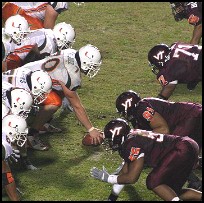 Historically,
the defense has been predicated on stopping the run and forcing the opponent to pass, thus making them a
one-dimensional team. Then you pressure the QB, trying to force the incompletion or the interception. As a peripheral
rule, the VT defense has played soft coverage on the corners and has been willing to give up the short completion
(which drives Tech fans nuts), but not the long stuff, not the big play.
Historically,
the defense has been predicated on stopping the run and forcing the opponent to pass, thus making them a
one-dimensional team. Then you pressure the QB, trying to force the incompletion or the interception. As a peripheral
rule, the VT defense has played soft coverage on the corners and has been willing to give up the short completion
(which drives Tech fans nuts), but not the long stuff, not the big play.
The idea is that you force the other team to move the ball down the field bit by bit, using the pass. Many coaches, including old-school coaches like Frank Beamer, believe that the large, large majority of teams in college football can't move the ball consistently with the pass and will either fail to get a first down or will turn it over more often than getting all the way down the field.
It's a pretty simple philosophy (most philosophies are) that like all football philosophies gets more complicated when you talk about what scheme you want to run to carry it out.
When I was growing up as a kid, I had a rudimentary understanding of defense from watching the NFL. You had 11 guys in a 4-3-4 configuration:
- 4 defensive linemen (2 ends and 2 tackles)
- 3 linebackers (1 middle linebacker and 2 outside linebackers)
- 4 defensive backs (2 cornerbacks and 2 safeties)
Then they invented this thing called the 3-4-4 (referred to as "the 3-4"), which removes one of the defensive tackles and replaces him with an extra middle linebacker.
Then they started talking about nickel packages (mostly for the 4-3-4), where you take out a linebacker or lineman and replace him with an extra cornerback in obvious passing downs.
So what kind of defense does Virginia Tech run? After the 2-8-1 debacle of 1992, the Hokies ditched their wide-tackle six defense and went looking for a new defense. One of the hottest defensive teams in the country at that time was the Washington Huskies, and VT went out and studied their defense, then hired a journeyman coach named Phil Elmassion to install it as VT's new defensive coordinator.
Elmassion never stays at one place for longer than two years, and that was how long he was at Tech: 1993 and 1994. While at Tech, he installed the Washington defense and taught it to Bud Foster and Rod Sharpless, who took over as co-defensive coordinators in 1995. Sharpless then committed career suicide by leaving Tech and going to Rutgers in 1996, but that's another story. Bud Foster has been the "DC" at Tech since 1996 and has continued to tweak and tune Tech's base Washington defense over the years.
Tech's defense doesn't really have a name, though many call it the "attack defense." At first glance, it looks like a standard 4-3-4, except it's really more of a 4-2-5. The defense employs the following configuration:
- 4 defensive linemen (2 ends and 2 tackles)
- 2 inside linebackers (a Mike and a Backer)
- 1 Whip linebacker
- 4 defensive backs (2 cornerbacks, 1 Rover, and 1 free safety)
What was new about this defense back in the early 1990's was its use of the Whip linebacker, who is really more of a big safety, with run-stopping and pass coverage abilities. In rushing situations, this defense looks like a 4-3-4, and in passing situations, due to the flexibility of the Whip linebacker, it can function like a 4-2-5, or a nickel package, with the Whip providing pass coverage responsibilities.
The Rover (strong safety) is physically very similar to the Whip linebacker, and in fact, VT has often rotated players between the Whip and Rover positions, if injuries warranted it. If memory serves correctly, Pierson Prioleau and Cory Bird both played Whip and Rover in their careers, though both were Rovers first, and Whips only if necessary.
The idea was that the personnel on the field could deal with any situation, pass or run, without requiring substitutions. This meant the defense could keep its eleven best players on the field all the time.
It also allowed the defense to bring eight men up in the box to stuff the run, (everybody but the free safety and cornerbacks), or drop five into coverage and rush the other six, pressuring the QB.
What Happened Next
The attack defense worked really well at first, because not everyone was running it, and offenses had a hard time dealing with it. The Hokies were also fortunate to get a few great pass rushers (Cornell Brown, Corey Moore, John Engelberger), a couple of good Whips (DeWayne Knight and Brandon Semones), and a succession of very good Rovers (Torrian Gray, Cory Bird, and Kevin McCadam). Combined with some solid DT's and good linebackers, the defense worked well.
(Ironically, the way VT has run it, cornerback is the least important position on the defense, in my opinion. VT has had great defenses with some average cornerbacks, because the DL, Whip, Rover, and LBs have been good. But as time has gone on, the cornerbacks have gotten more and more important, as the rest of the defense has been neutralized. Keep reading.)
But along the way, offenses started to respond with the following adjustments:
- Max protection: keeping the tight ends and running backs in to block all those blitzers.
- Short drops: taking three- to five-step drops to get rid of the ball quicker, instead of taking seven-step drops and standing in the pocket.
- Mobile QBs: guys who can move and avoid the rush.
- Using all the possible receivers: using the tight end and running backs in the passing game (contradictory to max protection, but effective, and it's all a chess game, anyway, pardon the reference).
- Power running from the spread formation: hard to do, but some teams, such as WVU, are good at it and are killing the Hokies with it.
- Zone blocking: instead of man responsibility, the offensive line is responsible for blocking an area, so they block whatever d-lineman enters it. Remember when VT used to shift the DL all around before the snap? I loved that -- they looked like rabid dogs on leashes, looking for a way to break free. They don't do that much anymore, and effective zone blocking is one of the reasons. That shifting doesn't confuse the OL as much anymore.
The first time I can recall an offense successfully combating the VT defense with some of those tools was the Miami of Ohio offense in their 24-17 upset of Tech back in 1997. The Hokies had a weak pass rush from the DL that year and had to blitz to get sacks, and Miami (OH) employed short drops and quick slants to pick up key first downs in that game. They handed a 4-0 Tech team their first loss of the year, and things went downhill from there.
Later on, Clemson would be a spread offense with short drops that wouldn't be successful against the Hokies, because they didn't have a power running game or a mobile QB in Brandon Streeter, and the Hokies had a great pass rush.
One team that tortures the Hokie defense and has done so since 1999 is Pittsburgh, which utilized max protection to its ultimate effectiveness against Tech's 1999 and 2001 defenses, gaining 415 yards in 1999 and 393 yards in 2001. Pitt recruited tall guys who could catch and tall guys who could throw and went to town, using max protect schemes to keep the QB from getting sacked (although VT did have nine sacks in 1999).
Teams like Miami and Florida State, meanwhile, beat the Hokies using the vertical passing game and in Miami's case, a full arsenal of weapons and superior talent.
Football is a constantly evolving collection of schemes and responses and new schemes and new responses, so how has VT responded to the offensive adjustments over the last couple of years?
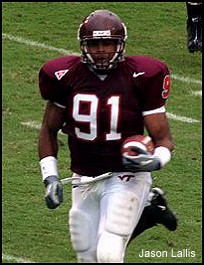 The
Hokies have countered with:
The
Hokies have countered with:
- Zone coverage, which VT doesn't run particularly well.
- Disguised coverages, like a zone blitz (linebackers blitz, and defensive linemen drop into coverage -- Jason Lallis scored on an interception against UCF this year using a zone blitz).
- A three-man rush, dropping eight back in coverage, which had good results against poor teams but mediocre results against good teams. (That was a 2002 experiment, mostly -- I don't recall seeing it in 2003.)
- Nickel substitutions, bringing in an extra cornerback. Tech tried this against Miami's Kellen Winslow this year, and it worked well.
So VT hasn't sat back and let offenses do what they wish without making some adjustments. The problem, I think, is that the advantages of the scheme have lessened over time. The biggest thing that has happened is that all-out blitzing isn't as successful a tactic as it used to be, so the Hokies have had to be more honest. The scheme advantage they used to get from blitzing has passed, and now it's down to talent versus talent, and mistakes aren't covered up as easily.
But I also think the scheme is capable of working just fine. It's no better or worse than any other scheme, and when properly run, with a few difference-makers stepping forward to make plays, it can be effective.
So What's the Problem?
We always wind up asking that question, and that's fine, because it's the reason we're here. The evolution of college football offenses has made blitzing less effective, but there's more to it than that. The 2001 defense wasn't a big blitzing, sacking, or "attacking" team, but it was nonetheless very effective, and ended up as the #2 yardage defense in the NCAA, by a very small margin. That defense was actually #1 until late in the year, when Texas edged it out on the last weekend of games.
Here are my thoughts on what's currently wrong with the defense. Many of you have criticized Bud Foster for laying the defense's problems at the feet of the players, and it will make you unhappy to learn that I mostly agree with him. I've watched a lot of film and conferred with a lot of people more knowledgeable than I, and most of VT's defensive trouble comes down to player talent and execution (unlike the offense, where I think the scheme and playcalling are holding the players back).
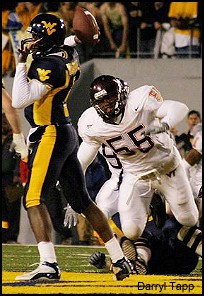 Lack
of a Great Pass Rusher. Last year, Lamar Cobb finished up a career in which he played in 40 games and had four
career sacks. With one game to go, Nathaniel Adibi has played in 47 games, starting 44 of them, and has 19.5 sacks.
Cols Colas has played in 47 games, starting 23, and has 19 sacks. Jim Davis (who redshirted this year) has played in
35 games, starting 9, and has 13.5 sacks.
Lack
of a Great Pass Rusher. Last year, Lamar Cobb finished up a career in which he played in 40 games and had four
career sacks. With one game to go, Nathaniel Adibi has played in 47 games, starting 44 of them, and has 19.5 sacks.
Cols Colas has played in 47 games, starting 23, and has 19 sacks. Jim Davis (who redshirted this year) has played in
35 games, starting 9, and has 13.5 sacks.
These are the guys to whom Virginia Tech has handed the pass-rushing responsibilities since Corey Moore and John Engelberger left after the 1999 season, and not one of them has ever posted a 10-sack season. Even with the benefit of a 14-game season (statistically) in 2002, Adibi and Colas peaked at 9 sacks each.
By contrast, Cornell Brown started for four years, much like Nathaniel Adibi, and had 36 sacks in 44 career games (not including bowl games), almost as much as Adibi and Colas combined. Brown had more than ten sacks in a season twice, putting up 11 in 1994 and 14 in 1995.
Corey Moore only played three seasons for Virginia Tech, starting two of them, and had 35 sacks in 33 games. He posted 13.5 sacks in 1998 and 17 in 1999. John Engelberger never had more than 10 sacks in a season, but he did have 26.5 sacks in 43 career games.
These guys were all great players, All-American caliber players, and they helped the VT defense fulfill one of its main goals: pressure the QB. They occupied more than one blocker, freeing up other defenders (meaning linebackers) to make plays. Adibi, Colas, Cobb, and so far Jim Davis have not been able to replace the production of Brown/Moore/Engelberger, and that makes a difference. It takes a lot of pressure off the offense and puts it back on the Tech defense.
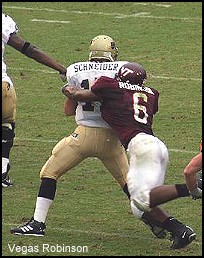 Lack
of Execution by the Linebackers. Here we go again. I hate picking on Mikal Baaqee and Vegas Robinson, but the
statistics and film analysis support me. Baaqee had 100 tackles this year, but just three tackles for loss, two of
which were sacks. This means that unlike last season, when he had 12 tackles for loss and 3.5 sacks, he simply wasn't
in the opponents' backfield on rushing plays. He had 8.5 tackles for loss on running plays in 2002 (12 TFLs - 3.5
sacks = 8.5 TFLs on run plays), but just one this year.
Lack
of Execution by the Linebackers. Here we go again. I hate picking on Mikal Baaqee and Vegas Robinson, but the
statistics and film analysis support me. Baaqee had 100 tackles this year, but just three tackles for loss, two of
which were sacks. This means that unlike last season, when he had 12 tackles for loss and 3.5 sacks, he simply wasn't
in the opponents' backfield on rushing plays. He had 8.5 tackles for loss on running plays in 2002 (12 TFLs - 3.5
sacks = 8.5 TFLs on run plays), but just one this year.
Vegas Robinson was more effective as a disrupter, totaling 8 tackles for loss, only one of which was a sack, meaning that he had seven tackles for loss in the running game.
But beyond the statistics are what we saw in film: Baaqee getting dragged backwards as he made tackles (one example is a tackle of UVa's Heath Miller I watched in which Miller caught a pass, and Baaqee not only let him pick up four yards as he waited passively for him, but he was dragged another four yards after contact. Baaqee gave up eight yards after Miller's catch, whereas a more physical linebacker may have given up just 1-3 yards. Those yards add up.); Vegas Robinson meeting Pittsburgh's Lousaka Polite in the hole on the Tech three yard line, only to get brushed off for the game-winning touchdown, or Robinson blitzing Texas A&M's Reggie McNeal untouched, only to give up outside containment and a long run for a first down. In watching VT film, examples abound of Baaqee and Robinson taking poor attack angles or not being physical enough.
Not to let the DL and DBs off the hook, either. The DL has been prone to inconsistent play from the tackles, and poor pursuit and attack angles from the defensive ends. Darryl Tapp, for example, has a lot of work to do in staying home and keeping containment to avoid getting burned. He stunted inside many times, only to have a running back like Quincy Wilson hit the corner he had just vacated for a big gain. Whether Tapp was told to crash down the line like that is known only to Darryl and his defensive coaches, but he had an inconsistent year stopping the run. Given that he'll be starting next year, he needs to improve.
While Corey Moore was lauded as a great pass rusher, he was also a fantastic run-stopper. If the play went away from him, Moore would first keep containment against the reverse and then would pursue down the line like a wild dog and make the tackle. It wasn't rare for him to make tackles on running plays that went to the other side of the field. When running backs did come to his side, they almost never got outside on him, either. I used to marvel at Moore's run defense, while everyone else was oohing and aahing at his sacks.
Freelancing by Defensive Backs. Bud Foster leveled the accusation in a press conference last week that some of his defenders were playing "selfish" football. He tried to back off of it later, but VT beat writers who were in the room tell me no, he said it. And you know what? He was right.
What does it mean when a defender is selfish? Isn't this a good thing, meaning that he's trying to make a play, instead of letting someone else make it? No, it's not a good thing. What it refers to -- other than a defender, say, getting in a fight on the sidelines and getting thrown out of the first half of the next game because he's too involved in his own drama to think of the team -- is players trying so hard to make a play that they're out of position.
In seeking a pass breakup, an interception, or a big tackle, a defensive back might leave his area of responsibility, or enter it late in an effort to make a big play and make himself look good. When a defensive back is not where he's supposed to be, it makes other defensive backs look bad � get it? Other defensive backs make decisions based on whether or not they think help is coming, and when they don't get expected help, they wind up looking foolish for not sticking with a guy or covering a guy more closely.
I saw a number of plays this year where teams got big gains against the Hokies, and I then saw defensive backs yapping at each other. I thought that DBs were just honestly blowing assignments, but now I wonder, were they willfully out of position by choice, only to have that choice backfire?
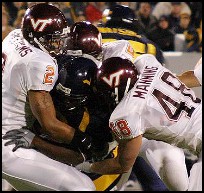 Lack
of the Attack Mentality. As I said, I hate criticizing guys like Mikal Baaqee or Vegas Robinson, because they're
great guys who are doing the best they can. But one thing I can't stand, and will be vocal about, is the number of VT
defenders I've seen standing around after plays this year, while a teammate made a solo tackle.
Lack
of the Attack Mentality. As I said, I hate criticizing guys like Mikal Baaqee or Vegas Robinson, because they're
great guys who are doing the best they can. But one thing I can't stand, and will be vocal about, is the number of VT
defenders I've seen standing around after plays this year, while a teammate made a solo tackle.
In the past, if you watched a VT football game on TV, every maroon helmet in the picture was attacking the ball carrier. They were like sharks at a feeding frenzy (that's at least three animal kingdom references so far, so I'll try to quit). Even the 1997 defense, which really struggled near the end of the season, went at it like there was no tomorrow. Watch the 1997 Miami-Virginia Tech game, if you've got a copy. The Hokies gave up oodles of yardage in that game with young defenders taking poor attack angles (James Jackson didn't get a zillion yards rushing that night because he was good -- he got it because defenders were out of position, God love Loren Johnson), but they never stopped going after the Canes. They attacked all game long.
Now, I see something really frustrating: VT defenders standing around while a teammate makes the tackle. VT defenders standing bolt upright as a tackled ball carrier falls at their feet. VT defenders out-and-out watching while a teammate makes a tackle three yards away. This isn't the defense I know and love. They look like they've lost their fire, and that could be a confidence issue. After all, they got after it pretty well against Syracuse and Miami, and look how that turned out.
Coaching/Playcalling
This is where it gets hard (for me, anyway) to talk about a defense. It's easy, too easy, to critique the offensive playcalling, but defensive playcalling, for the layman, is more obscure. So I won't spend a lot of time on this, but I will discuss four things.
Number one is the soft coverage VT showed against Pittsburgh in the last game-winning drive for the Panthers. The Hokies rushed four rushers (except for one early blitz) during that drive, and they also laid back in coverage, giving Larry Fitzgerald plenty of room to work. On Fitzgerald's first catch, a 29-yarder that cut the field from 70 yards to 41 yards in one play, he made his cut 25 yards downfield, and DeAngelo Hall, at that point in time, was ten yards away from Fitzgerald and backpedaling. Argh.
My take on that is, if you're set up as an attack defense, then attack. If you've got a great cover corner like Hall, then put him in coverage and let him give Fitzgerald his best shot. After all, Eric Green held Fitzgerald in check most of the game. Make them beat your best with their best, and if they do, so be it.
The counterpoint to that, and my second point of discussion, is the long touchdown pass that put Boston College ahead of the Hokies for good. That play was a third and ten, and the Hokies blitzed every linebacker, rushing seven players and leaving four players back in coverage. Vince Fuller was left alone with Grant Adams when free safety Mike Daniels had to make a read on the tight end and cover the tight end. BC QB Paul Peterson made a great throw, Adams made a great one-handed catch, and Fuller made a very poor attempt at a tackle around the VT 15-yard line. The rest is history.
The difference in the two situations is that I didn't feel the Hokies were put in position to make the play and win against Pittsburgh. I feel they were put in position to make the play against BC, and they just didn't. They were beaten by a good throw and catch. It was a gutsy call by Bud Foster, some say too gutsy, but if you're going to criticize him for not pressuring Pittsburgh, you can't criticize him for pressuring BC in a critical situation.
My third point of discussion is the fact that UVa's Heath Miller was open all day long, despite VT knowing he was a threat to catch the ball. Sometimes it's hard to account for a tight end, because they block, hold that block until the linebackers read the play and go elsewhere, and then release. I saw this a few times in the UVa game, and with the way UVa uses their backs in the passing game -- which draws the linebackers -- it was effective.
Other times, Miller simply went out in the pattern and was unaccounted for. Wide open. Surely something could have been done to get a man on him and slow him down, but VT didn't make the adjustments and put their players in position to stop him. I'm not sure what could have been done, but when an opponent has one of the best receiving days in the history of Tech football, you find yourself thinking something should have been done.
Lastly, personnel. There's more to coaching than scheming and playcalling. There's personnel decisions. And I have two questions regarding personnel decisions:
1.) If the defense had players who were freelancing, were undisciplined, or were chemistry problems, then why didn't those players spend serious time on the bench, to send them a message? Without naming names, there were guys who should have accumulated some quality pine time for their attitudes and their execution on the field. I think that in retrospect, the Hokie coaches agree, but I also think they err on the side of wanting to have their best athletes on the field, even when those athletes are creating problems with their attitudes or selfish play.
2.) Why didn't Jordan Trott play more? Trott's not perfect -- watch Wali Lundy's last TD run in the Virginia game, and you'll see Trott completely whiff a tackle that leads to Lundy scoring -- but he's bigger and more physical then Mikal Baaqee, and he makes more tackles for loss. Looking at the hokiesports the newspaper depth chart, Baaqee had one tackle for every 5.63 snaps from scrimmage, and Trott had one for every 5.56 snaps, so they're equal there, but while taking roughly half the snaps, Trott had five tackles for loss against the running game to just one for Baaqee. Trott had two tackles for loss against the run in the Miami game alone, more than double what Baaqee had for the entire season. I'm not sure what the coaches see from Trott and Baaqee in practice that makes them start Baaqee over Trott, but during the games, Trott was equally productive in tackles and much more productive in tackles for loss. And at 6-4, he can make plays Baaqee (5-10) can't make. Remember Trott tipping the pass against Virginia, leading to an interception? I think Baaqee is too short to make that play.
Conclusions
I don't think coaching is the major problem here, thought it's not perfect. The bigger problems for the Hokies, in my opinion, have been a lack of playmakers on defense, primarily at defensive end, defensive tackle, and inside linebacker. Coupled with a lack of discipline in the secondary (both in terms of penalties and assignments) and just a general lack of fire-in-the-belly, this has made the VT defense fall into a slide that is now two years old and threatens to go on longer.
Looking at the defensive stats listed near the top of this article, you can see that three of the worst defenses (statistically) in the Beamer bowl era have come in the last four years. 2000 could be blamed on youth, and 2002 could be blamed on youth and injuries, but 2003 can't use either excuse.
The VT coaches need to crack down on the undisciplined play, make some tough personnel decisions, and recruit better pass rushers and run-stoppers. Lastly, tell everyone who steps on the field for the Virginia Tech defense to give it a hundred percent on every play, from effort to assignments, or they'll be benched in favor of someone who does, SuperPrep rankings and Rivals.com stars be damned. I'd rather have a lightly-recruited head-knocker like George Del Ricco any day over a highly-rated "superstar" who does his own thing, accumulates penalties, and takes plays off.
Lastly, tweak the system some more. Take a good look at what offenses are doing around the country and what the more successful defenses are doing to combat it, and make some adjustments. Take a visit to Kansas State, for example, where they used zone coverage and pressure on the QB to completely shut down Oklahoma in the Big 12 championship game.
I don't know if the things that trouble the Virginia Tech defense can be fixed in the offseason. I don�t know if it's a long process or a short one, and I don't know if it will just take better players, new coaching blood, or both. But the Hokies need a defense they can count on, and they haven't been able to count on this one at all the last two years.
Next Up: Special Teams
The Hokies are still blocking kicks and returning punts well, but they're giving up big kick return yardage and
have lost confidence in their field goal kickers. We'll take a look at the special teams next.